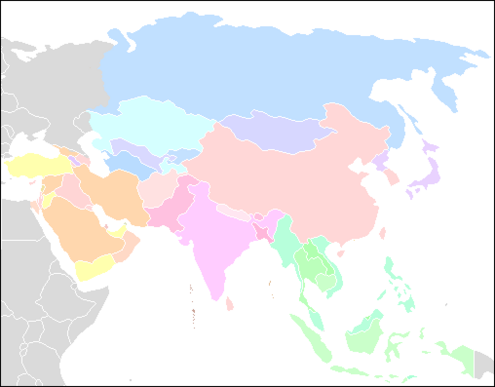Asia
| Demonym | Asian |
|---|---|
| Countries | 49 UN members 1 UN observer 5 other states |
| Dependencies | |
| Non-UN states | |
| Languages | List of languages |
| Time zones | UTC+02:00 to UTC+12:00 |
| Internet TLD | .asia |
| Largest cities | |
| UN M49 code | 142 – Asia001 – World |

Asia (/ˈeɪʒə/ ⓘ AY-zhə, UK also /ˈeɪʃə/ AY-shə) is the largest continent[note 1][10][11] in the world by both land area and population.[11] It covers an area of more than 44 million square kilometers,[note 2] about 30% of Earth's total land area and 8% of Earth's total surface area. The continent, which has long been home to the majority of the human population,[12] was the site of many of the first civilizations. Its 4.7 billion people[13] constitute roughly 60% of the world's population.[14]
Asia shares the
Asia varies greatly across and within
Definition and boundaries
Asia–Africa boundary
The boundary between Asia and Africa is the
Asia–Europe boundary
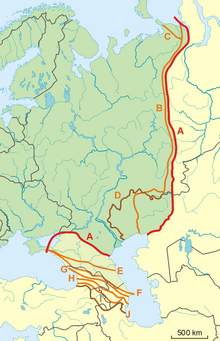
The threefold division of the
The border between Asia and Europe was historically defined by European academics.
In Sweden, five years after Peter's death, in 1730
Asia–Oceania boundary
The border between Asia and the region of Oceania is usually placed somewhere in the Indonesia Archipelago. The Maluku Islands are often considered to lie on the border of southeast Asia, with Indonesian New Guinea, to the east of the islands, being wholly part of Oceania. The terms Southeast Asia and Oceania, devised in the 19th century, have had several vastly different geographic meanings since their inception. The chief factor in determining which islands of the Indonesian Archipelago are Asian has been the location of the colonial possessions of the various empires there (not all European). Lewis and Wigen assert, "The narrowing of 'Southeast Asia' to its present boundaries was thus a gradual process."[28]
Asia–North America boundary
The
St. Lawrence Island in the northern Bering Sea belongs to Alaska and may be associated with either continent but is almost always considered part of North America, as with the Rat Islands in the Aleutian chain. At their nearest points, Alaska and Russia are separated by only 4 kilometres (2.5 miles).
Ongoing definition

Geographical Asia is a cultural artifact of European conceptions of the world, beginning with the Ancient Greeks, being imposed onto other cultures, an imprecise concept causing endemic contention about what it means. Asia does not exactly correspond to the cultural borders of its various types of constituents.[34]
From the time of Herodotus a minority of geographers have rejected the three-continent system (Europe, Africa, Asia) on the grounds that there is no substantial physical separation between them.[35] For example, Sir Barry Cunliffe, the emeritus professor of European archeology at Oxford, argues that Europe has been geographically and culturally merely "the western excrescence of the continent of Asia".[36]
Geographically, Asia is the major eastern constituent of the continent of Eurasia with Europe being a northwestern peninsula of the landmass. Asia, Europe and Africa make up a single continuous landmass—Afro-Eurasia (except for the Suez Canal)—and share a common continental shelf. Almost all of Europe and a major part of Asia sit atop the Eurasian Plate, adjoined on the south by the Arabian and Indian Plate and with the easternmost part of Siberia (east of the Chersky Range) on the North American Plate.
Etymology

The term "Asia" is believed to originate in the
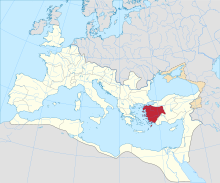
The term was later adopted by the Romans, who used it in reference to the province of Asia, located in western Anatolia.[46] One of the first writers to use Asia as a name of the whole continent was Pliny.[47]
History
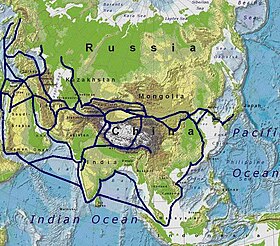

The history of Asia can be seen as the distinct histories of several peripheral coastal regions:
The central steppe region had long been inhabited by horse-mounted nomads who could reach all areas of Asia from the steppes. The earliest postulated expansion out of the steppe is that of the Indo-Europeans, who spread their languages into West Asia, South Asia, and the borders of China, where the Tocharians resided. The northernmost part of Asia, including much of Siberia, was largely inaccessible to the steppe nomads, owing to the dense forests, climate and tundra. These areas remained very sparsely populated.
The center and the peripheries were mostly kept separated by mountains and deserts. The
The Islamic Caliphate's defeats of the Byzantine and Persian empires led to West Asia and southern parts of Central Asia and western parts of South Asia under its control during its conquests of the 7th century. The Mongol Empire conquered a large part of Asia in the 13th century, an area extending from China to Europe. Before the Mongol invasion, Song dynasty reportedly had approximately 120 million citizens; the 1300 census which followed the invasion reported roughly 60 million people.[49]
The Black Death, one of the most devastating pandemics in human history, is thought to have originated in the arid plains of central Asia, where it then travelled along the Silk Road.[50]
The Russian Empire began to expand into Asia from the 17th century, and would eventually take control of all of Siberia and most of Central Asia by the end of the 19th century. The Ottoman Empire controlled Anatolia, most of the Middle East, North Africa and the Balkans from the mid 16th century onwards. In the 17th century, the Manchu conquered China and established the Qing dynasty. The Islamic Mughal Empire and the Hindu Maratha Empire controlled much of India in the 16th and 18th centuries respectively.[51]
Western European colonisation of Asia coincided with the Industrial Revolution in the West and the dethroning of India and China as the world's foremost economies.[52] The British Empire became dominant in South Asia, with large parts of the region first being conquered by British traders before falling under direct British rule; extreme poverty doubled to over 50% during this era.[53] The Middle East was contested and partitioned by the British and French,[54] while Southeast Asia was carved up between the British, Dutch and French.[55] Various Western powers dominated China in what later became known as the "century of humiliation", with the British-supported opium trade and later Opium Wars resulting in China being forced into an unprecedented situation of importing more than it exported.[56][57] Foreign domination of China was furthered by the Empire of Japan, which controlled most of East Asia and much of Southeast Asia, New Guinea and the Pacific islands during this era; Japan's domination was enabled by its rapid rise that had taken place during the Meiji era of the late 19th century, in which it applied industrial knowledge learned from the West and thus overtook the rest of Asia.[58][59]
With the end of World War II in 1945 and the wartime ruination of Europe and imperial Japan, many countries in Asia were able to rapidly free themselves of colonial rule.[60] The independence of India came along with the carving out of a separate nation for the majority of Indian Muslims, which today has become the countries Pakistan and Bangladesh.[61]
Some Arab countries took economic advantage of massive oil deposits that were discovered in their territory, becoming globally influential.[62] East Asian nations (along with Singapore in Southeast Asia) became economically prosperous with high-growth "tiger economies",[63] with China regaining its place among the top two economies of the world by the 21st century.[64] India has grown significantly because of economic liberalisation that started in the 1990s,[65] with extreme poverty now below 20%.[66]
-
The threefold division of theGreek geographers such as Anaximander and Hecataeus.
-
1825 map of Asia by Sidney Edwards Morse
-
Map of western, southern, and central Asia in 1885[67]
-
The map of Asia in 1796, which also included the continent of Australia (then known as New Holland)
-
1890 map of Asia
Geography
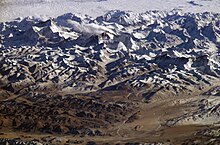
Asia is the largest
The
-
Siberian tundra
-
Rainforest in Borneo
-
Mongolian steppe
Main regions

There are various approaches to the regional division of Asia. The following subdivision into regions is used, among others, by the
- North Asia (Siberia)[note 3]
- Central Asia
- West Asia (The Middle East or Near East and the Caucasus)
- South Asia
- East Asia (Far East)
- Southeast Asia (East Indies and Indochina)
Climate

Asia has extremely diverse climate features. Climates range from arctic and subarctic in Siberia to tropical in southern India and Southeast Asia. It is moist across southeast sections, and dry across much of the interior. Some of the largest daily temperature ranges on Earth occur in western sections of Asia. The monsoon circulation dominates across southern and eastern sections, due to the presence of the Himalayas forcing the formation of a thermal low which draws in moisture during the summer. Southwestern sections of the continent are hot. Siberia is one of the coldest places in the Northern Hemisphere, and can act as a source of arctic air masses for North America. The most active place on Earth for tropical cyclone activity lies northeast of the Philippines and south of Japan.
Climate change
Climate change is having major impacts on many countries in the continent. A survey carried out in 2010 by global risk analysis farm Maplecroft identified 16 countries that are extremely vulnerable to climate change. Each nation's vulnerability was calculated using 42 socio, economic and environmental indicators, which identified the likely climate change impacts during the next 30 years. The Asian countries of Bangladesh, India, the Philippines, Vietnam, Thailand, Pakistan, China and Sri Lanka were among the 16 countries facing extreme risk from climate change.[71][72][73] Some shifts are already occurring. For example, in tropical parts of India with a semi-arid climate, the temperature increased by 0.4 °C between 1901 and 2003. A 2013 study by the International Crops Research Institute for the Semi-Arid Tropics (ICRISAT) aimed to find science-based, pro-poor approaches and techniques that would enable Asia's agricultural systems to cope with climate change, while benefiting poor and vulnerable farmers. The study's recommendations ranged from improving the use of climate information in local planning and strengthening weather-based agro-advisory services, to stimulating diversification of rural household incomes and providing incentives to farmers to adopt natural resource conservation measures to enhance forest cover, replenish groundwater and use renewable energy.[74]
The ten countries of the Association of Southeast Asian Nations (ASEAN) – Brunei,
Economy

Asia has the largest continental economy in the world by both GDP nominal and PPP values, and is the fastest growing economic region.[76] As of 2023[update], China is by far the largest economy on the continent, making up nearly half of the continent's economy by GDP nominal. It is followed by Japan, India, South Korea, Indonesia, Saudi Arabia and Turkey, which are all ranked amongst the top 20 largest economies both by nominal and PPP values.[77] Based on Global Office Locations 2011, Asia dominated the office locations with 4 of the top 5 being in Asia: Hong Kong, Singapore, Tokyo and Seoul. Around 68 percent of international firms have an office in Hong Kong.[78]
In the late 1990s and early 2000s, the economy of China
In the late 1980s and early 1990s, Japan's GDP by currency exchange rates was almost as large as that of the rest of Asia combined.[76] In 1995, Japan's economy nearly equaled that of the US as the largest economy in the world for a day, after the Japanese currency reached a record high of 79 yen/US$. Economic growth in Asia since World War II to the 1990s had been concentrated in Japan as well as the four regions of South Korea, Taiwan, Hong Kong and Singapore located in the Pacific Rim, known as the Asian tigers, which are now all considered developed economies, having amongst the highest GDP per capita in Asia.[86][76]

Asia is the largest continent in the world by a considerable margin, and it is rich in natural resources, such as petroleum, forests, fish, water, rice, copper and silver. Manufacturing in Asia has traditionally been strongest in East and Southeast Asia, particularly in China, Taiwan, South Korea, Japan, India, the Philippines, and Singapore. Japan and South Korea continue to dominate in the area of multinational corporations, but increasingly the PRC and India are making significant inroads. Many companies from Europe, North America, South Korea and Japan have operations in Asia's developing countries to take advantage of its abundant supply of cheap labour and relatively developed infrastructure.[citation needed]
According to
Trade between Asian countries and countries on other continents is largely carried out on the sea routes that are important for Asia. Individual main routes have emerged from this. The main route leads from the Chinese coast south via Hanoi to Jakarta, Singapore and Kuala Lumpur through the
In 2010, Asia had 3.3 million millionaires (people with net worth over US$1 million excluding their homes), slightly below North America with 3.4 million millionaires. In 2011, Asia topped Europe in number of millionaires.[96] Citigroup in The Wealth Report 2012 stated that Asian centa-millionaire overtook North America's wealth for the first time as the world's "economic center of gravity" continued moving east. At the end of 2011, there were 18,000 Asian people mainly in Southeast Asia, China and Japan who have at least $100 million in disposable assets, while North America with 17,000 people and Western Europe with 14,000 people.[97]
| Rank | Country | GDP (nominal, Peak Year)
millions of USD |
Peak Year |
|---|---|---|---|
| 1 | 17,700,899 | 2023 | |
| 2 | 4,230,862 | 2023 | |
| 3 | 3,732,224 | 2023 | |
| 4 | 1,862,470 | 2023 | |
| 5 | 1,709,232 | 2021 | |
| 6 | 1,417,387 | 2023 | |
| 7 | 1,154,600 | 2023 | |
| 8 | 1,069,437 | 2023 | |
| 9 | 751,930 | 2023 | |
| 10 | 521,688 | 2023 |
| Rank | Country | GDP (PPP, Peak Year) millions of USD |
Peak Year |
|---|---|---|---|
| 1 | 32,897,929 | 2023 | |
| 2 | 13,119,622 | 2023 | |
| 3 | 6,495,214 | 2023 | |
| 4 | 5,326,855 | 2022 | |
| 5 | 4,393,370 | 2023 | |
| 6 | 3,613,540 | 2023 | |
| 7 | 2,924,189 | 2023 | |
| 8 | 2,246,535 | 2023 | |
| 9 | 1,809,425 | 2023 | |
| 10 | 1,725,874 | 2023 |
Tourism
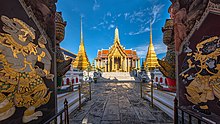
With growing Regional Tourism with domination of Chinese visitors,
Demographics
| Year | Pop. | ±% p.a. | ||
|---|---|---|---|---|
| 1500 | 243,000,000 | — | ||
| 1700 | 436,000,000 | +0.29% | ||
| 1900 | 947,000,000 | +0.39% | ||
| 1950 | 1,402,000,000 | +0.79% | ||
| 1999 | 3,634,000,000 | +1.96% | ||
| 2016 | 4,462,676,731 | +1.22% | ||
| ||||
| Source: "UN report 2004 data" (PDF). The figure for 2021 is provided by.the 2022 revision of the World Population Prospects[2][3] | ||||

East Asia had by far the strongest overall Human Development Index (HDI) improvement of any region in the world, nearly doubling average HDI attainment over the past 40 years, according to the report's analysis of health, education and income data. China, the second highest achiever in the world in terms of HDI improvement since
1970, is the only country on the "Top 10 Movers" list due to income rather than health or education achievements. Its per capita income increased a stunning 21-fold over the last four decades, also lifting hundreds of millions out of income poverty. Yet it was not among the region's top performers in improving school enrollment and life expectancy.[100]
Nepal, a South Asian country, emerges as one of the world's fastest movers since 1970 mainly due to health and education achievements. Its present life expectancy is 25 years longer than in the 1970s. More than four of every five children of school age in Nepal now attend primary school, compared to just one in five 40 years ago.[100]
Hong Kong ranked highest among the countries grouped on the HDI (number 7 in the world, which is in the "very high human development" category), followed by Singapore (9), Japan (19) and South Korea (22). Afghanistan (155) ranked lowest amongst Asian countries out of the 169 countries assessed.[100]
Languages
Asia is home to several language families and many language isolates. Most Asian countries have more than one language that is natively spoken. For instance, according to Ethnologue, more than 700 languages are spoken in Indonesia, more than 400 languages spoken in India, and more than 100 are spoken in the Philippines. China has many languages and dialects in different provinces.
Religions
Many of the world's
Abrahamic


The
Judaism, the oldest of the Abrahamic faiths, is practiced primarily in Israel, the indigenous homeland and historical birthplace of the Hebrew nation: which today consists both of those Jews who remained in the Middle East and those who returned from diaspora in Europe, North America, and other regions;[104] though various diaspora communities persist worldwide. Jews are the predominant ethnic group in Israel (75.6%) numbering at about 6.1 million,[105] although the levels of adherence to Jewish religion vary. Outside of Israel there are small ancient Jewish communities in Turkey (17,400),[106] Azerbaijan (9,100),[107] Iran (8,756),[108] India (5,000) and Uzbekistan (4,000),[109] among many other places. In total, there are 14.4–17.5 million (2016, est.)[110] Jews alive in the world today, making them one of the smallest Asian minorities, at roughly 0.3 to 0.4 percent of the total population of the continent.
The
The
Indian and East Asian religions
Almost all Asian religions have philosophical character and Asian philosophical traditions cover a large spectrum of philosophical thoughts and writings.
As of 2012[update], Hinduism has around 1.1 billion adherents. The faith represents around 25% of Asia's population and is the largest religion in Asia. However, it is mostly concentrated in South Asia. Over 80% of the populations of both India and Nepal adhere to Hinduism, alongside significant communities in Bangladesh, Pakistan, Bhutan, Sri Lanka and Bali, Indonesia. Many overseas Indians in countries such as Burma, Singapore and Malaysia also adhere to Hinduism.
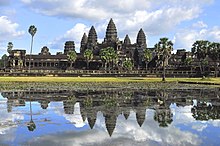
Buddhism has a great following in mainland Southeast Asia and East Asia. Buddhism is the religion of the majority of the populations of
-
Japanese wedding at the Meiji Shrine
-
Tamilcommunity
-
Bar mitzvah at the Western Wall in Jerusalem
-
Catholic procession of the Black Nazarene in Manila
-
Ziyarat al-Nabi Shu'ayb festival at the tomb of the prophet in Hittin
-
Christian Armenians praying at the Etchmiadzin Cathedral in Vagharshapat
-
Muslim men praying at the Ortaköy Mosque in Istanbul
-
Buddhist Monks performing traditional Sand mandala made from coloured sand
Modern conflicts and events



Some of the events pivotal in Asia related to the relationship with the outside world in the post-
- The Partition of India (1947):
Led to the creation of India and Pakistan, shaping the political landscape in South Asia.
- The Indo-Pakistani War of 1947–1948:
Fought over the princely state of Jammu and Kashmir, setting the stage for future conflicts.
- The Chinese Civil War (1927–1949):
Culminated in the establishment of the People's Republic of China under the Communist Party.
- The Korean War (1950–1953):
Involved international forces and led to the division of the Korean Peninsula.
- The First Indochina War (1946–1954):
Ended with the defeat of French colonial forces and the partition of Vietnam.
- The Vietnam War (1955–1975):
A protracted conflict with significant global implications, especially during the Cold War.
- The Sino-Vietnamese War (1979):
Conflict between China and Vietnam following Vietnam's invasion of Cambodia.
- The Indonesian occupation of East Timor (1975–1999):
Involved Indonesia's annexation and subsequent independence through a UN-backed referendum.
- The Soviet–Afghan War (1979–1989):
Soviet intervention in Afghanistan, contributing to the rise of the mujahideen.
- The Iran–Iraq War (1980–1988):
Long-lasting conflict with regional and international implications.
- The Gulf War (1990–1991):
Resulted from Iraq's invasion of Kuwait, with international intervention.
- The Dissolution of the Soviet Union (1991):
Marked the end of the Cold War and the emergence of independent states.
- The War in Afghanistan (2001–2021):
U.S.-led intervention post-9/11 with long-lasting consequences.
- The Iraq War (2003–2011):
Led to the overthrow of Saddam Hussein and subsequent instability.
- The Arab Spring (2010–2012):
Series of uprisings and protests across the Arab world, influencing regional dynamics.
- The Syrian Civil War (2011–present):
Ongoing conflict with widespread humanitarian implications.
Culture
The
Nobel prizes
The
Other Asian writers who won Nobel Prize for literature include
Also,
Sir
Japan has won the most Nobel Prizes of any Asian nation with 24 followed by India which has won 13.
Amartya Sen (born 3 November 1933) is an Indian economist who was awarded the 1998 Nobel Memorial Prize in Economic Sciences for his contributions to welfare economics and social choice theory, and for his interest in the problems of society's poorest members.
Other Asian Nobel Prize winners include
In 2006, Muhammad Yunus of Bangladesh was awarded the Nobel Peace Prize for the establishment of Grameen Bank, a community development bank that lends money to poor people, especially women. He is known for the concept of micro credit which, allows poor and destitute people to borrow money. The borrowers pay back money within the specified period and defaulting is very low. The Dalai Lama received the Nobel Peace Prize, in Oslo, Norway in 1989.[143]
States of Asia
| Symbol | Flag | Name | (2021) |
Area (km2) |
Capital |
|---|---|---|---|---|---|
| Afghanistan | 40,099,462 | 652,864 | Kabul | ||
| Armenia | 2,790,974 | 29,743 | Yerevan | ||
| Azerbaijan[note 4] | 10,312,992 | 86,600 | Baku | ||
| Bahrain | 1,463,265 | 760 | Manama | ||
| Bangladesh | 169,356,251 | 147,570 | Dhaka | ||
| Bhutan | 777,486 | 38,394 | Thimphu | ||
| Brunei | 445,373 | 5,765 | Bandar Seri Begawan | ||
| Cambodia | 16,589,023 | 181,035 | Phnom Penh | ||
| China (PRC) | 1,425,893,465 | 9,596,961 | Beijing | ||
| Cyprus | 1,244,188 | 9,251 | Nicosia | ||
| East Timor | 1,320,942 | 14,874 | Dili | ||
| Egypt[note 4] | 109,262,178 | 1,001,449 | Cairo | ||
| Georgia[note 4] | 3,757,980 | 69,700 | Tbilisi | ||
| India | 1,407,563,842 | 3,287,263 | New Delhi | ||
| Indonesia[note 4] | 273,753,191 | 1,904,569 | Jakarta | ||
| Iran | 87,923,432 | 1,648,195 | Tehran | ||
| Iraq | 43,533,592 | 438,317 | Baghdad | ||
| Israel | 8,900,059 | 20,770 | Jerusalem (disputed) | ||
| Japan | 124,612,530 | 377,915 | Tokyo | ||
| Jordan | 11,148,278 | 89,342 | Amman | ||
| Kazakhstan[note 4] | 19,196,465 | 2,724,900 | Astana | ||
| Kuwait | 4,250,114 | 17,818 | Kuwait City | ||
| Kyrgyzstan | 6,527,743 | 199,951 | Bishkek | ||
| Laos | 7,425,057 | 236,800 | Vientiane | ||
| Lebanon | 5,592,631 | 10,400 | Beirut | ||
| Malaysia | 33,573,874 | 329,847 | Kuala Lumpur | ||
| Maldives | 521,457 | 298 | Malé | ||
| Mongolia | 3,347,782 | 1,564,116 | Ulaanbaatar | ||
| Myanmar | 53,798,084 | 676,578 | Naypyidaw | ||
| Nepal | 30,034,989 | 147,181 | Kathmandu | ||
| North Korea | 25,971,909 | 120,538 | Pyongyang | ||
| Oman | 4,520,471 | 309,500 | Muscat | ||
| Pakistan | 211,103,000 | 881,913 | Islamabad | ||
| Palestine | 5,133,392 | 6,220 |
| ||
| Philippines | 113,880,328 | 343,448 | Manila | ||
| Qatar | 2,688,235 | 11,586 | Doha | ||
| Russia[note 5] | 145,102,755 | 17,098,242 | Moscow[note 6] | ||
| Saudi Arabia | 35,950,396 | 2,149,690 | Riyadh | ||
| Singapore | 5,941,060 | 697 | Singapore | ||
| South Korea | 51,830,139 | 100,210 | Seoul | ||
| Sri Lanka | 21,773,441 | 65,610 | Sri Jayawardenepura Kotte | ||
| Syria | 21,324,367 | 185,180 | Damascus | ||
| Tajikistan | 9,750,064 | 143,100 | Dushanbe | ||
| Thailand | 71,601,103 | 513,120 | Bangkok | ||
| Turkey[note 7] | 84,775,404 | 783,562 | Ankara | ||
| Turkmenistan | 6,341,855 | 488,100 | Ashgabat | ||
| United Arab Emirates | 9,365,145 | 83,600 | Abu Dhabi | ||
| Uzbekistan | 34,081,449 | 447,400 | Tashkent | ||
| Vietnam | 97,468,029 | 331,212 | Hanoi | ||
| Yemen | 32,981,641 | 527,968 |
Within the above-mentioned states are several partially recognized countries with limited to no international recognition. None of them are members of the UN:
| Symbol | Flag | Name | Population |
Area (km2) |
Capital |
|---|---|---|---|---|---|
| Abkhazia | 242,862 | 8,660 | Sukhumi | ||
| Northern Cyprus | 326,000 | 3,355 | North Nicosia | ||
| South Ossetia | 51,547 | 3,900 | Tskhinvali | ||
| Taiwan (ROC) | 23,859,912 | 36,193 | Taipei |

| 0.900–1.000 0.800–0.899 0.700–0.799 | 0.600–0.699 0.500–0.599 0.400–0.499 | 0.300–0.399 0.200–0.299 0.100–0.199 | 0.000–0.099 No data |
The most
See also
Special topics:
- Asian Century
- Asian cuisine
- Asian furniture
- Asian Games
- Asia-Pacific
- Asian Para Games
- Asian Monetary Unit
- Asian people
- Eastern world
- Eurasia
- Far East
- East Asia
- Southeast Asia
- South Asia
- Central Asia
- West Asia
- North Asia
- Fauna of Asia
- Flags of Asia
- Middle East
- Pan-Asianism
Lists:
- List of cities in Asia
- List of metropolitan areas in Asia by population
- List of sovereign states and dependent territories in Asia
Projects
- Asian Highway Network
- Trans-Asian Railway
Notes
- ^ Asia is normally considered its own continent in the English speaking world, which uses the seven continent model.[8][9] Other models consider Asia as part of a Eurasian or Afro-Eurasian continent (see Continent#Number for more information).
- ^ 44,579,000 square kilometres (17,212,000 square miles)
- ^ Siberia lies in Asia geographically, but is considered a part of Europe culturally and politically.
- ^ Transcontinental country
- ^ Russia is a transcontinental country located in Eastern Europe and North Asia, but is considered European historically, culturally, ethnically, and politically, and the vast majority of its population (78%) lives within its European part.
- ^ Moscow is located in Europe.
- transcontinental country located mainly in West Asia with a smaller portion in Southeastern Europe.
References
- ^ National Geographic Family Reference Atlas of the World. Washington, DC: National Geographic Society (U.S.). 2006. p. 264.
- ^ a b c "World Population Prospects 2022". United Nations Department of Economic and Social Affairs, Population Division. Retrieved 17 July 2022.
- ^ a b c "World Population Prospects 2022: Demographic indicators by region, subregion and country, annually for 1950-2100" (XSLX) ("Total Population, as of 1 July (thousands)"). United Nations Department of Economic and Social Affairs, Population Division. Retrieved 17 July 2022.
- ^ "GDP PPP, current prices". International Monetary Fund. 2022. Archived from the original on 22 January 2021. Retrieved 16 January 2022.
- ^ "GDP Nominal, current prices". International Monetary Fund. 2022. Archived from the original on 25 February 2017. Retrieved 16 January 2022.
- ^ "Nominal GDP per capita". International Monetary Fund. 2022. Archived from the original on 11 January 2020. Retrieved 16 January 2022.
- from the original on 1 August 2023. Retrieved 4 August 2023.
- ^ "Asia noun". Oxford Learner's Dictionaries. Archived from the original on 22 March 2022. Retrieved 16 February 2023.
- ^ "Asia Definition & Meaning". Merriam Webster. Archived from the original on 16 February 2023. Retrieved 16 February 2023.
- ^ "Asia: The largest continent on Earth". BBC Bitesize. Archived from the original on 7 October 2022.
- ^ a b Boudreau, Diane; McDaniel, Melissa; Sprout, Erin; Turgeon, Andrew. Evers, Jeannie; West, Kara (eds.). "Asia: Physical Geography". National Geographic Society. Crooks, Mary; Gunther, Tim; Wynne, Nancy. Archived from the original on 30 June 2022. Retrieved 4 February 2023.
- ^ "The World at Six Billion". UN Population Division. Archived from the original on 5 March 2016, "Table 2" (PDF). Archived from the original (PDF) on 1 January 2016.
- ^ "Asia Population 2022 (Demographics, Maps, Graphs)". World Population Review. Archived from the original on 21 February 2022. Retrieved 21 February 2022.
- ^ "Population of Asia. 2019 demographics: density, ratios, growth rate, clock, rate of men to women". populationof.net. Archived from the original on 14 July 2019. Retrieved 2 June 2019.
- ^ ISBN 978-0-7922-7528-2. "Europe" (pp. 68–69); "Asia" (pp. 90–91): "A commonly accepted division between Asia and Europe is formed by the Ural Mountains, Ural River, Caspian Sea, Caucasus Mountains, and the Black Sea with its outlets, the Bosporus and Dardanelles."
- ^ Nalapat, M. D. "Ensuring China's 'Peaceful Rise'". Archived from the original on 10 January 2010. Retrieved 22 January 2016.
- ^ ISBN 978-0-8213-5005-8. Archivedfrom the original on 4 March 2008. Retrieved 1 June 2010.
- ^ "The Real Great Leap Forward". The Economist. 30 September 2004. Archived from the original on 27 December 2016.
- ^ "Like herrings in a barrel". The Economist. No. Millennium issue: Population. 23 December 1999. Archived from the original on 4 January 2010.
- S2CID 126449508.
- ^ Histories 4.38. C.f. James Rennell, The Geographical System of Herodotus Examined and Explained, Volume 1, Rivington 1830, p. 244
- ^ according to Strabo (Geographica 11.7.4) even at the time of Alexander, "it was agreed by all that the Tanais river separated Asia from Europe" (ὡμολόγητο ἐκ πάντων ὅτι διείργει τὴν Ἀσίαν ἀπὸ
τῆς Εὐρώπης ὁ Τάναϊς ποταμός; c.f. Duane W. Roller, Eratosthenes' Geography, Princeton University Press, 2010, ISBN 978-0-691-14267-8. Archivedfrom the original on 26 March 2022. Retrieved 21 January 2020.)
- ^ W. Theiler, Posidonios. Die Fragmente, vol. 1. Berlin: De Gruyter, 1982, fragm. 47a.
- ISBN 978-0-521-60443-7. Archivedfrom the original on 1 August 2020. Retrieved 21 January 2020.
- ^ Geographia 7.5.6 (ed. Nobbe 1845, Ptolomeo, Claudio (1845). "vol. 2". Archived from the original on 24 May 2020. Retrieved 21 January 2020., p. 178) Καὶ τῇ Εὐρώπῃ δὲ συνάπτει διὰ τοῦ μεταξὺ αὐχένος τῆς τε Μαιώτιδος λίμνης καὶ τοῦ Σαρματικοῦ Ὠκεανοῦ ἐπὶ τῆς διαβάσεως τοῦ Τανάϊδος ποταμοῦ. "And [Asia] is connected to Europe by the land-strait between Lake Maiotis and the Sarmatian Ocean where the river Tanais crosses through."
- ^ a b Lineback, Neal (9 July 2013). "Geography in the News: Eurasia's Boundaries". National Geographic. Archived from the original on 8 May 2016. Retrieved 9 June 2016.
- ^ Lewis & Wigen 1997, pp. 27–28
- ^ Lewis & Wigen 1997, pp. 170–173
- ISBN 978-1317464006. Archivedfrom the original on 4 April 2023. Retrieved 23 April 2022.
- ^ Wallace, Alfred Russel (1879). Australasia. The University of Michigan. p. 2. Archived from the original on 30 July 2022. Retrieved 12 March 2022.
Oceania is the word often used by continental geographers to describe the great world of islands we are now entering upon [...] This boundless watery domain, which extends northwards of Behring Straits and southward to the Antarctic barrier of ice, is studded with many island groups, which are, however, very irregularly distributed over its surface. The more northerly section, lying between Japan and California and between the Aleutian and Hawaiian Archipelagos is relived by nothing but a few solitary reefs and rocks at enormously distant intervals.
- ISBN 978-0295800509. Archivedfrom the original on 17 May 2023. Retrieved 12 March 2022.
The regional name of the Pacific Islands is appropriate: Oceania, a sea of islands, including those of Alaska and Hawaii. The Pacific Basin is not insignificant or remote. It covers one third of the globe's surface. Its northern boundary is the Aleutian Islands chain. Oceania virtually touches all of the Western Hemisphere.
- ^ Flick, Alexander Clarence (1926). Modern World History, 1776-1926: A Survey of the Origins and Development of Contemporary Civilization. A.A. Knopf. p. 492. Archived from the original on 30 July 2022. Retrieved 10 July 2022.
- ^ Henderson, John William (1971). Area Handbook for Oceania. U.S. Government Printing Office. p. 5. Archived from the original on 6 April 2023. Retrieved 11 March 2022.
- ^ Lewis & Wigen 1997, pp. 7–9
- ^ "Asia". AccessScience. McGraw-Hill. Archived from the original on 27 November 2011. Retrieved 26 July 2011.
- ^ Schwartz, Benjamin (December 2008). "Geography Is Destiny". The Atlantic. Archived from the original on 30 September 2009.
- .
- ^ Bossert, Helmut T., Asia, Istanbul, 1946.
- ISBN 978-0-521-76207-6.
- ^ Ventris & Chadwick 1973, pp. 410, 536
- ISBN 978-1-78297-475-8. Archivedfrom the original on 4 December 2022. Retrieved 7 March 2023.
assuwa pylos "aswia" = Linear B A-si-wi-ja
- ^ Book IV, Article 45.
- ^ "Asie". Encyclopedia: Greek Gods, Spirits, Monsters. Theoi Greek Mythology, Exploring Mythology in Classical Literature and Art. 2000–2011. Archived from the original on 4 June 2010.
- ^ Μ95, Π717.
- ^ Β461.
- ^ Henry George Liddell; Robert Scott; Henry Stuart Jones; Roderick McKenzie (2007) [1940]. "Ἀσία". A Greek-English Lexicon. Medford: Perseus Digital Library, Tufts University. Archived from the original on 27 April 2011.
- ^ "Asia – Origin and meaning of Asia by Online Etymology Dictionary". Etymonline.com. Archived from the original on 25 May 2017. Retrieved 9 November 2017.
- ^ Silkroad Foundation, Adela C.Y. Lee. "Ancient Silk Road Travellers". Silk-road.com. Archived from the original on 8 November 2017. Retrieved 9 November 2017.
- ^ Ping-ti Ho. "An Estimate of the Total Population of Sung-Chin China", in Études Song, Series 1, No 1, (1970). pp. 33–53.
- ^ "History – Black Death". BBC. 17 February 2011. Archived from the original on 5 June 2012.
- ISBN 978-0-230-32885-3. Archivedfrom the original on 22 April 2020.
- ^ "How India's Economy Will Overtake the U.S.'s". Time. 28 July 2023. Archived from the original on 31 August 2023. Retrieved 31 August 2023.
- ^ Sullivan, Dylan; Hickel, Jason. "How British colonialism killed 100 million Indians in 40 years". Al Jazeera. Archived from the original on 15 January 2023. Retrieved 4 September 2023.
- from the original on 31 August 2023. Retrieved 31 August 2023.
- ^ "Southeast Asia, 1800–1900 A.D. | Chronology | Heilbrunn Timeline of Art History | The Metropolitan Museum of Art". The Met's Heilbrunn Timeline of Art History. Archived from the original on 31 August 2023. Retrieved 31 August 2023.
- ^ "Milestones: 1830–1860 - Office of the Historian". history.state.gov. Archived from the original on 31 August 2023. Retrieved 31 August 2023.
- ^ "Opinion | For China, the history that matters is its 'century of humiliation'". South China Morning Post. 28 September 2021. Archived from the original on 31 August 2023. Retrieved 31 August 2023.
- ^ "Introduction: Race and Empire in Meiji Japan". The Asia-Pacific Journal: Japan Focus. Archived from the original on 31 August 2023. Retrieved 31 August 2023.
- from the original on 31 August 2023. Retrieved 31 August 2023.
- ^ "Global war's colonial consequences". academic.oup.com. Archived from the original on 31 August 2023. Retrieved 31 August 2023.
- from the original on 23 April 2019. Retrieved 31 August 2023.
- ^ "Oil Discovered in Saudi Arabia". education.nationalgeographic.org. Archived from the original on 3 December 2023. Retrieved 31 August 2023.
- ^ "Economic Issues 1 -- Growth in East Asia". imf.org. Archived from the original on 20 March 2023. Retrieved 31 August 2023.
- ^ Saul, Derek. "China And India Will Overtake U.S. Economically By 2075, Goldman Sachs Economists Say". Forbes. Archived from the original on 5 July 2023. Retrieved 31 August 2023.
- ^ "25 years of liberalisation: A glimpse of India's growth in 14 charts-Business News". Firstpost. 7 July 2016. Archived from the original on 4 September 2023. Retrieved 4 September 2023.
- ^ Kumar, Manoj (17 July 2023). "One-tenth of India's population escaped poverty in 5 years - government report". Reuters. Archived from the original on 4 September 2023. Retrieved 4 September 2023.
- ^ "A Map of the Countries between Constantinople and Calcutta: Including Turkey in Asia, Persia, Afghanistan and Turkestan". Wdl.org. 1885. Archived from the original on 17 October 2017. Retrieved 9 November 2017.
- ^ "Asia". Encyclopædia Britannica Online. Chicago: Encyclopædia Britannica, Inc. 2006. Archived from the original on 18 November 2008.
- ^ "Standard Country or Area Codes for Statistical Use (M49 Standard)". UN Statistica Division. Archived from the original on 30 August 2017. Retrieved 2 May 2020. "Geographic Regions" anklicken Zitat: "The assignment of countries or areas to specific groupings is for statistical convenience and does not imply any assumption regarding political or other affiliation of countries or territories by the United Nations."
- PMID 30375988.
- ^ "Asia tops climate change's 'most vulnerable' list". New Scientist. Archived from the original on 13 April 2021. Retrieved 17 December 2020.
- ^ "Which countries are most threatened by and vulnerable to climate change?". Iberdrola. Archived from the original on 27 November 2020. Retrieved 17 December 2020.
- ^ "Global Climate Risk Index 2020 – World". ReliefWeb. 5 December 2019. Archived from the original on 27 November 2020. Retrieved 17 December 2020.
- ICRISAT, Policy Brief No. 23, February 2013
- hdl:11250/2734506.
- ^ a b c d International Monetary Fund. "World Economic Outlook Database, April 2023". International Monetary Fund. Archived from the original on 13 April 2023. Retrieved 7 May 2023.
- ^ "Largest_Economies_in_Asia". Aneki.com. Archived from the original on 30 July 2022. Retrieved 9 November 2017.
- ^ "Hong Kong, Singapore, Tokyo World's Top Office Destinations". CFO innovation ASIA. Archived from the original on 7 August 2011. Retrieved 21 July 2011.
- SSRN 916768.
- ISBN 978-0-19-164758-1. Archivedfrom the original on 24 September 2020. Retrieved 30 May 2021.
- ISBN 978-9264104143. Archivedfrom the original on 14 April 2021. Retrieved 30 May 2021.
- ISBN 978-0-226-03463-8.
- ^ "Table B–18. World GDP, 20 Countries and Regional Totals, 0–1998 A.D." (PDF). theworldeconomy.org. Archived (PDF) from the original on 22 July 2013. Retrieved 20 September 2021.
- ^ Professor M.D. Nalapat (11 September 2001). "Ensuring China's "Peaceful Rise"". Bharat-rakshak.com. Archived from the original on 10 January 2010. Retrieved 1 June 2010.
- ^ "The Real Great Leap Forward". The Economist. 30 September 2004. Archived from the original on 27 December 2016. Retrieved 1 June 2010.
- ^ "Rise of Japan and 4 Asian Tigers from". emergingdragon.com. Archived from the original on 22 April 2010. Retrieved 1 June 2010.
- ^ "Philippine potential cited". sme.com.ph. 24 February 2011. Archived from the original on 24 April 2011. Retrieved 1 March 2011.
- ^ "Estimated containerized cargo flows on major container trade routes in 2020, by trade route". Archived from the original on 9 January 2021. Retrieved 26 January 2021.
- ^ "Global Marine Trends 2030 Report" (PDF). Archived (PDF) from the original on 12 April 2021. Retrieved 26 January 2021.
- ^ "Maritime Trade". Archived from the original on 19 March 2021. Retrieved 26 January 2021.
- ^ Harry G. Broadman "Afrika's Silk Road" (2007), pp 59.
- ^ Harry de Wilt: Is One Belt, One Road a China crisis for North Sea main ports? in World Cargo News, 17. December 2019.
- ^ Bernhard Simon: Can The New Silk Road Compete With The Maritime Silk Road? in The Maritime Executive, 1 January 2020.
- ^ Jean-Marc F. Blanchard "China's Maritime Silk Road Initiative and South Asia" (2018).
- ^ "INTRA-ASIA". Archived from the original on 26 January 2021. Retrieved 26 January 2021.
- ^ "Asia has more millionaires than Europe". Toronto. Archived from the original on 25 June 2011.
- ^ Vallikappen, Sanat (28 March 2012). "Citigroup Study Shows Asian Rich Topping North American". Bloomberg L.P. Archived from the original on 14 January 2015.
- ^ "World Bank's GDP (PPP) Data for Russia" (PDF). Archived (PDF) from the original on 5 August 2023. Retrieved 14 July 2023.
- ^ "Milan and Rome named among the most widely visited cities in the world in the Mastercard Global Destination Cities Index report". Italianavenue.com. 28 May 2013. Archived from the original on 17 October 2017. Retrieved 9 November 2017.
- ^ a b c "2010 Human Development Report: Asian countries lead development progress over 40 years" (PDF). UNDP. Archived (PDF) from the original on 21 November 2010. Retrieved 22 December 2010.
- ISBN 978-0-8156-5257-1.
- ISBN 978-1-4462-8976-1.
The Middle East is the cradle of the three monotheistic faiths of Judaism, Christianity and Islam.
- ISBN 978-1-317-45572-1.
- ^ "The Jewish Population of the World". Jewishvirtuallibrary.org. Archived from the original on 21 June 2010. Retrieved 1 June 2010.
- ^ Ettinger, Yoram (5 April 2013). "Defying demographic projections". Israel Hayom. Archived from the original on 29 October 2013. Retrieved 29 October 2013.
- ^ "Turkey Virtual Jewish History Tour | Jewish Virtual Library". jewishvirtuallibrary.org. Archived from the original on 11 October 2014. Retrieved 15 December 2014.
- ^ "Ethnic composition of Azerbaijan 2009". Pop-stat.mashke.org. 7 April 1971. Archived from the original on 7 February 2012. Retrieved 22 December 2012.
- ^ "Jewish woman brutally murdered in Iran over property dispute". The Times of Israel. 28 November 2012. Archived from the original on 19 August 2014. Retrieved 16 August 2014.
A government census published earlier this year indicated there were a mere 8,756 Jews left in Iran
See Persian Jews#Iran - ^ "World Jewish Population 2007" (PDF). Archived from the original (PDF) on 26 March 2009. Retrieved 18 July 2015., American Jewish Yearbook, vol. 107 (2007), p. 592.
- ^ "World Jewish Population 2016 (DellaPergola, AJYB) | Berman Jewish DataBank". jewishdatabank.org. Archived from the original on 30 September 2017. Retrieved 24 March 2018.
- ^ "Christians". Pew Research Center's Religion & Public Life Project. 18 December 2012. Archived from the original on 10 March 2015. Retrieved 13 March 2015.
- ISBN 978-1-62513-171-3. Archivedfrom the original on 29 April 2016. Retrieved 13 March 2015.
- ^ a b c d "Global Christianity – A Report on the Size and Distribution of the World's Christian Population" (PDF). Pew Research Center. Archived (PDF) from the original on 9 August 2021. Retrieved 16 February 2022.
- ISBN 978-0-7369-4807-4.
- ISBN 978-0-8028-2417-2.
- ^ "Region: Asia-Pacific". Pewforum.org. 27 January 2011. Archived from the original on 10 October 2017. Retrieved 9 November 2017.
- ISBN 978-0-429-96200-4.
Worldwide, they number 1 million or so, with about 45 to 50 percent in Syria, 35 to 40 percent in Lebanon, and less than 10 percent in Israel. Recently there has been a growing Druze diaspora.
- ^ Jha, Preeti (26 December 2007). "Guinness comes to east Delhi: Akshardham world's largest Hindu temple". The Indian Express. Archived from the original on 28 December 2007. Retrieved 2 January 2008.
- ^ "Cambodia". The World Factbook (2024 ed.). Central Intelligence Agency. Retrieved 20 December 2010. (Archived 2010 edition.)
- ^ "Thailand". The World Factbook (2024 ed.). Central Intelligence Agency. Retrieved 20 December 2010. (Archived 2010 edition.)
- ^ "burma". The World Factbook (2024 ed.). Central Intelligence Agency. Retrieved 20 December 2010. (Archived 2010 edition.)
- ^ "Japan". The World Factbook (2024 ed.). Central Intelligence Agency. Retrieved 20 December 2010. (Archived 2010 edition.)
- ^ "Bhutan". The World Factbook (2024 ed.). Central Intelligence Agency. Retrieved 20 December 2010. (Archived 2010 edition.)
- ^ "The Census of Population and Housing of Sri Lanka-2011". Department of Census and Statistics. Archived from the original on 24 July 2013. Retrieved 29 July 2013.
- ^ "Laos". The World Factbook (2024 ed.). Central Intelligence Agency. Retrieved 20 December 2010. (Archived 2010 edition.)
- ^ "Mongolia". The World Factbook (2024 ed.). Central Intelligence Agency. Retrieved 20 December 2010. (Archived 2010 edition.)
- ^ "Taiwan". The World Factbook (2024 ed.). Central Intelligence Agency. Retrieved 20 December 2010. (Archived 2010 edition.)
- ^ "China (includes Taiwan only): International Religious Freedom Report 2005". US Department of State: Bureau of Democracy, Human Rights, and Labor. 8 November 2005. Archived from the original on 26 December 2020. Retrieved 24 January 2008.
- US Department of State: Bureau of Democracy, Human Rights, and Labor. 15 September 2006. Archivedfrom the original on 17 September 2020. Retrieved 24 February 2008.
- US Department of State: Bureau of Democracy, Human Rights, and Labor. 15 September 2006. Archivedfrom the original on 25 June 2020. Retrieved 24 February 2008.
- ^ "South Korea". The World Factbook (2024 ed.). Central Intelligence Agency. Retrieved 20 December 2010. (Archived 2010 edition.)
- ^ "Malaysia". The World Factbook (2024 ed.). Central Intelligence Agency. Retrieved 20 December 2010. (Archived 2010 edition.)
- ^ "Nepal". The World Factbook (2024 ed.). Central Intelligence Agency. Retrieved 20 December 2010. (Archived 2010 edition.)
- ^ "vietnam". The World Factbook (2024 ed.). Central Intelligence Agency. Retrieved 20 December 2010. (Archived 2010 edition.)
- ^ "Chinese Han Nationality: Language, Religion, Customs". Travelchinaguide.com. Archived from the original on 17 October 2017. Retrieved 9 November 2017.
- ^ "Culture of North Korea – Alternative name, History and ethnic relations". Countries and Their Cultures. Advameg Inc. Archived from the original on 5 August 2009. Retrieved 4 July 2009.
- ^ "North Korea". The World Factbook (2024 ed.). Central Intelligence Agency. Retrieved 9 November 2017. (Archived 2017 edition.)
- ^ Bureau of East Asian and Pacific Affairs (2009). "Background Note: North Korea". U.S. State Department. Archived from the original on 18 August 2020. Retrieved 4 July 2009.
- ^ "Geographic Regions". United Nations. Archived from the original on 30 August 2017. Retrieved 31 March 2018.
- ^ Collon, Dominique. "BBC - History - Ancient History in depth: Mesopotamia". Archived from the original on 2 January 2023. Retrieved 31 March 2018.
- OCLC 751789199.
- ISBN 978-1285783086. Archivedfrom the original on 26 March 2023. Retrieved 31 March 2018.
- ^ His Holiness's Teachings at TCV. "A Brief Biography – The Office of His Holiness The Dalai Lama". Dalailama.com. Archived from the original on 25 May 2010. Retrieved 1 June 2010.
- ^ "Democracy Report 2024, Varieties of Democracy" (PDF). Archived (PDF) from the original on 12 March 2024. Retrieved 16 March 2024.
Bibliography
- Lewis, Martin W.; Wigen, Kären (1997). The myth of continents: a critique of metageography. Berkeley and Los Angeles: University of California Press. ISBN 978-0-520-20743-1.
- Ventris, Michael; Chadwick, John (1973). Documents in Mycenaean Greek (2nd ed.). Cambridge: University Press.
Further reading
- Embree, Ainslie T., ed. Encyclopedia of Asian history (1988)
- Higham, Charles. Encyclopedia of Ancient Asian Civilizations. Facts on File library of world history. New York: Facts On File, 2004.
- Kamal, Niraj. "Arise Asia: Respond to White Peril". New Delhi: Wordsmith, 2002, ISBN 978-81-87412-08-3
- Kapadia, Feroz, and Mandira Mukherjee. Encyclopaedia of Asian Culture and Society. New Delhi: Anmol Publications, 1999.
- Levinson, David, and Karen Christensen, eds. Encyclopedia of Modern Asia. (6 vol. Charles Scribner's Sons, 2002).
External links
- Asia web resources provided by GovPubs at the University of Colorado Boulder Libraries
- Asia at the Encyclopædia Britannica
- Asia: Human Geography at the National Geographic Society
- Asia at Curlie
- Asian Reading Room from the United States Library of Congress
- . Encyclopædia Britannica. Vol. 2 (11th ed.). 1911. pp. 320–358.
- "Display Maps". The Soil Maps of Asia. European Digital Archive of Soil Maps – EuDASM. Archived from the original on 12 August 2011. Retrieved 26 July 2011.
- "Asia Maps". Perry–Castañeda Library Map Collection. University of Texas Libraries. Archived from the original on 18 July 2011. Retrieved 20 July 2011.
- "Asia". Norman B. Leventhal Map Center at the Boston Public Library. Archived from the original on 29 September 2011. Retrieved 26 July 2011.
- Bowring, Philip (12 February 1987). "What is Asia?". Eastern Economic Review. 135 (7). Archived from the original on 28 July 2011. Retrieved 22 April 2009.



![Map of western, southern, and central Asia in 1885[67]](http://upload.wikimedia.org/wikipedia/commons/thumb/2/23/A_Map_of_the_Countries_between_Constantinople_and_Calcutta-_Including_Turkey_in_Asia%2C_Persia%2C_Afghanistan_and_Turkestan_WDL11753.png/120px-A_Map_of_the_Countries_between_Constantinople_and_Calcutta-_Including_Turkey_in_Asia%2C_Persia%2C_Afghanistan_and_Turkestan_WDL11753.png)




















